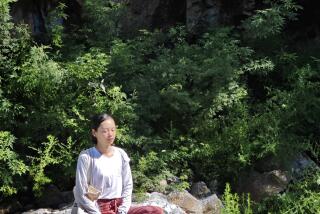China’s oldest drum tower is Zengchong village’s beating heart

More than a century before the Declaration of Independence was drafted and about 175 years before California became a state, inhabitants of this southern Chinese village erected an elaborate drum tower.
Built without nails, its 11 octagonal tiers stack up like a wedding cake 82 feet tall. Painted roosters, chickens, peacocks and ducks, in bright blues, greens and yellows, dance around the edges, frolicking in trees and bamboo groves. An octagonal two-story turret caps the structure like a fancy stopper on a giant perfume bottle.
In many ways, life in this remote hamlet, perched along the hairpin bend of a river in Guizhou province, seems to have changed little since the tower went up in 1672.
There are no fast-food restaurants, no mini-marts, not even a traffic light; the village feels like it has one foot in the 17th century. Men still drive donkey carts through the cobblestone streets while women arrive from the nearby green hills hauling bundles of kindling on their backs.
Stooped elderly women hobble through the narrow alleyways, peddling handmade brooms as sows oink from their sties and roaming roosters cluck. Butchers wield their cleavers at the roadsides, carving up chickens, pigs and dogs and cooking them over flames.
At the center of village life, the tower stands strong and straight, a venue for festive gatherings, a site for flirting, a pavilion for settling disputes. Hanging high in the rafters, the giant drum is an instrument of both welcome and warning.
In the center of the tower’s open-sided ground floor, a massive hearth beckons citizens to warm their kettles over the coals and discuss important village business, town-hall style — or simply shoot the breeze.
On a recent overcast Monday morning, 53-year-old Shi Qinghui sat next to the fire pit dressed in a blue sport coat, white shirt and red and yellow slippers. Holding a cigarette in his left hand and a sickle in his right, he delicately shaved a piece of bamboo into long green reeds. He planned to weave them into a trap to catch river shrimp.
A few other men of similar vintage hovered nearby, one occasionally rising to throw another 5-foot log onto the flames.
Except for the hottest months of the year, the fire is lighted each morning and kept burning until 10 or 11 each night, Shi said. Each of the 300 families in Zengchong is responsible for keeping the embers going at least one day a year.
“There’s no chart to keep track of who’s on duty when,” he said. “People just remember important stuff like that.”
Like almost everyone in Zengchong, Shi has lived his entire life here and is a member of the Dong ethnic minority. He was a child when he learned what various drumbeats signified. “Three repeated beats — ba-bump, ba-bump, ba-bump — that’s when we gather to sing,” he said. “Six beats — ta-ta-ta-ta-ta-ta — that means an enemy is coming.”
Shi is old enough to remember Mao Tse-tung’s 1966-76 Cultural Revolution, when communist authorities and rabid young Red Guards launched a terrifying campaign to smash the “four olds”: old customs, old habits, old ideas and old culture.
“They tried to get us to burn the drum,” Shi recalled. “But we wouldn’t listen. Imagine what would have happened if we had followed those orders. This tower would be gone.”
Thanks to the villagers’ disobedience, Zengchong’s signature structure now holds the title of China’s oldest drum tower — 343 years and counting. These days, local Communist Party officials see it as a calling card to put Zengchong on the tourist map.
Another Dong village in the region, Sanbao, claims to have the world’s tallest drum tower. Local authorities have gussied it up for tourists. A sign out front even boasts of its inclusion in the Guinness Book of World Records, though curiously, there’s no mention of the drum tower on the official Guinness website. Visitors pay a $1.60 entrance fee, and once inside, signposts guide them toward sights such as the “Souvenir Commodity Street.”
In Zengchong, a construction crew is hard at work paving the bumpy dirt slope that links the village to a main road that connects to the town of Tingdong, 29 miles away. A new brown sign along the roadway spells out “Zengchong” in English letters, the better to guide foreigners.
How such developments may change Zengchong remains to be seen. Small signs of modernity are already evident. Nowadays, satellite dishes sprout from the roofs of weather-beaten huts, delivering programs such as “The Voice of China” to flat-screen TVs inside. Toddlers drive battery-powered toy cars through the narrow streets.
But the sightseer trade has yet to arrive with any gusto. There are no souvenir shops in Zengchong, no hawkers pushing postcards or T-shirts or factory-made “ethnic clothes.”
Around the corner from the drum tower, the clack-clack of a loom echoed from behind the wooden door of Meng Guangzhi’s house.
Inside, a charcoal brazier and one fluorescent bulb lighted the dim workshop of the 46-year-old. Sitting barefoot at her rustic contraption, she passed a brass shuttle back and forth rapidly through the hanging threads, turning white cotton thread into a tight bolt of fabric with a small diamond pattern.
The fabric will be dyed with indigo and sewn into artfully trimmed women’s jackets like the one Meng was wearing. Sensing the opportunity to acquire an authentic handicraft, a foreign visitor asked Meng whether she might part with some of the cloth.
“Sell it?” Meng replied, somewhat startled. “No, I can’t do that. We need it here to make the clothes.”
More to Read
Sign up for Essential California
The most important California stories and recommendations in your inbox every morning.
You may occasionally receive promotional content from the Los Angeles Times.











